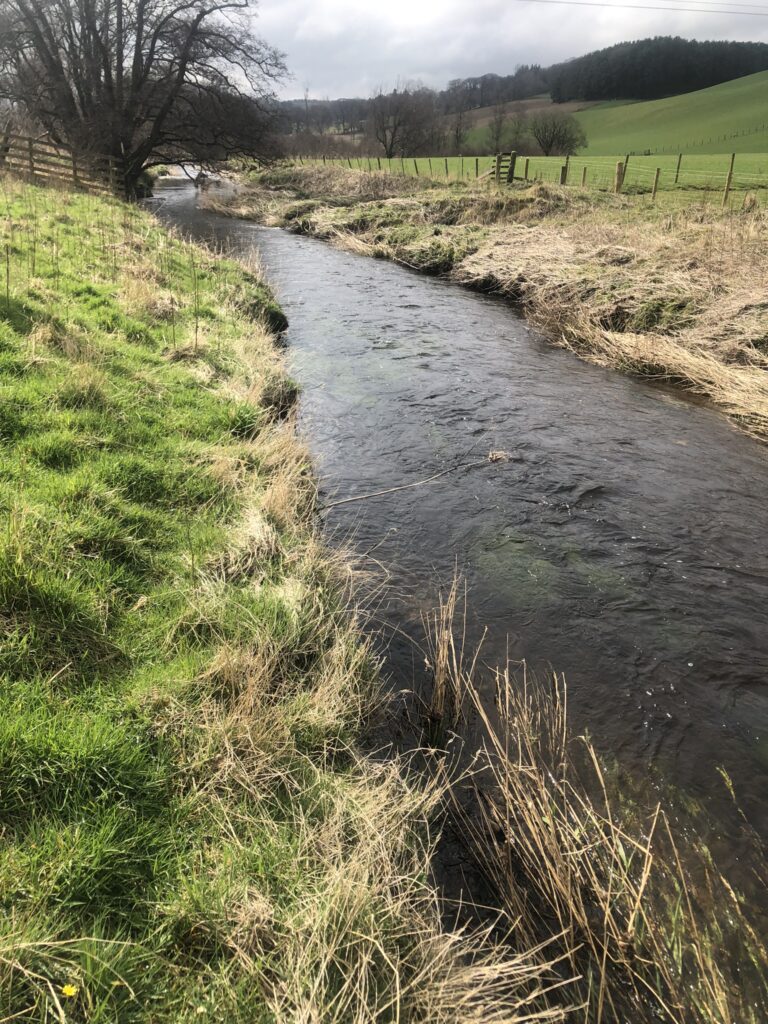In this 1000 Better Story Shona Macintosh (biog below) reflects on the challenges and solutions of natural flood management at Eddleston Waters in the Scottish Borders.
In a traditional Scottish Borders hotel, over coffee and biscuits, the keepers of river knowledge pass round their maps. I am here to visit Eddleston Water, the pioneering project that is transforming the landscape by planting trees, digging ponds and building ‘large woody structures’: all with the aim of slowing and storing water as it runs down towards Peebles. This is Natural Flood Management in action, and it has been undertaken by the Tweed Forum: a collaborative group of landowners and other community stakeholders who have come together to figure out ways to restore both the land and its waterways.
There are maps of the river today, some showing the underlying geology, some showing the location of the various interventions that have been carried out. But it’s a map from around 1790 which grabs my attention. When this was made, that same landscape out the window was the backdrop to a moment in time when the French revolution was raging, Burns was writing his Poems, Chiefly in the Scottish Dialect, and right here at Cringletie, industrialists were building a railway and artificially straightening the river beside it. It was a common approach, but one which has left us today with a difficult legacy in many places. Rivers that have been channelized (in some cases until they resemble canals) speed up the flow of water, which can worsen flood risk for residents who live alongside or downstream.
From Cringletie we head out to see a spot right by the A703 (and its new segregated cycle lane!) where the river has been re-meandered – or given its wiggle back, as I prefer to think of it. The old straightened section is still there: ponded, boggy, and home at this time of year to the most frogspawn I have ever seen in one place. But the main river is now winding its way with more ease, the ripples on its surface an indication, apparently, of a good variation in the riverbed which helps create friction – a key ingredient in ‘slowing the flow’.

So does it work, and if so, how do we get more of it across the country? With climate change leaving more communities at risk of flooding, it’s vital we use all the tools at our disposal to protect ourselves. The interventions trialled at Eddelston have been shown to work best in small flood events and over a small catchment area (up to 35km²), so in larger catchments, or to protect against bigger flood events, consensus is that they need to be combined with traditional ‘grey’ infrastructure – engineered flood defences. But how best to do this is still being figured out. It is very hard to incorporate the uncertain effects of natural interventions into traditional cost-benefit analysis for public spending projects.
Leaving the Borders and reflecting on my visit, I think I have begun to piece it together. The benefits of landscape restoration go so far beyond flood management that it would be foolish only to assess (or fund) them in that light. The ‘return’ offered at Eddelston for multiple environmental benefits has been estimated at over £4 million, only £950 000 of which is estimated as flood damages avoided. It also seems clear that if you are trying to convince landowners to change the use of their land, coming along with a formal Flood Protection Scheme and asking them to sign a contract that will bind their use of the land in perpetuity, is not likely to be much of a carrot! A more flexible approach is needed. Flood risk engineers tend to talk of being ‘cautious’ in their risk assessments, meaning that they assume the worst flood event and build defences to protect against this. Communities may (and increasingly do) say that this leads to over-engineering relative to the level of risk people are happy to live with.
Perhaps wholescale adoption of NFM, funded through agricultural subsidies and biodiversity/nature recovery funds as well as flood management, could allow us to be less cautious, and therefore spend less time, money and carbon emissions on those engineering projects that will still be needed? Proper landscape transformation across all our catchments will take decades – so it is urgent that we begin now! (Everything, everywhere, all at once, as UN Secretary-General recently put it).
What kind life on the land can we imagine for our descendants? The landscapes in which we live now will be marked by more extreme ebbs and flows of water, and of temperature. If we can be fit caretakers of the rural landscapes ‘upstream’, then the built environments in our towns and villages ‘downstream’ will be better protected. Their inhabitants will benefit from the bounce-back of natural species and improved water, soil and air quality that come alongside that. Perhaps we need to get rid of the upstream/downstream, urban/rural dichotomies altogether? The sooner we can see ourselves as all fitting into the same cycles – of water, food production, seasons – the better prepared we will be to work together. Friction can result in conflict (‘Don’t build that wall there!’ or ‘You’re not putting that mess on my land!’), but it can also be the source of those beautiful sparkling ripples on the surface of a stream: the sign of a flow which is taking its time on its way to the outfall.

Shona McIntosh lives in Musselburgh and is a Green Councillor for East Lothian. She has two small children, so spends as much time outdoors as possible (preferably on two wheels, and often on the lookout for sticks and seashells –as well as frogspawn). She is on Twitter (ShonaMcIn_SGP) and Instagram (@shonascottishgreens).

